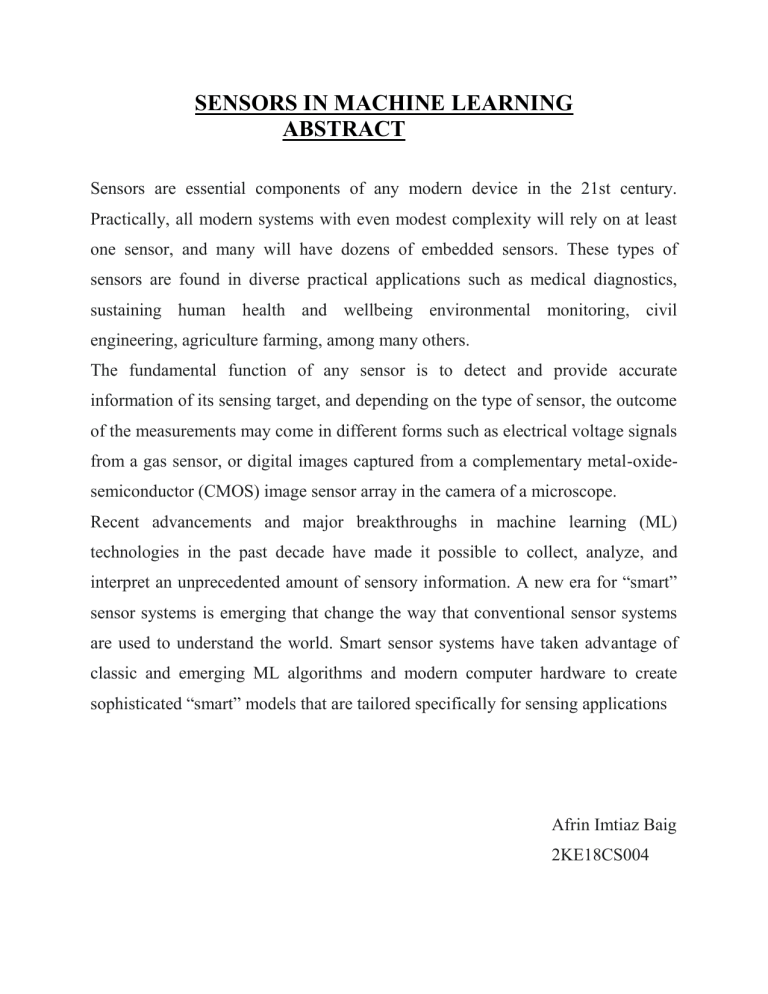
SENSORS IN MACHINE LEARNING ABSTRACT Sensors are essential components of any modern device in the 21st century. Practically, all modern systems with even modest complexity will rely on at least one sensor, and many will have dozens of embedded sensors. These types of sensors are found in diverse practical applications such as medical diagnostics, sustaining human health and wellbeing environmental monitoring, civil engineering, agriculture farming, among many others. The fundamental function of any sensor is to detect and provide accurate information of its sensing target, and depending on the type of sensor, the outcome of the measurements may come in different forms such as electrical voltage signals from a gas sensor, or digital images captured from a complementary metal-oxidesemiconductor (CMOS) image sensor array in the camera of a microscope. Recent advancements and major breakthroughs in machine learning (ML) technologies in the past decade have made it possible to collect, analyze, and interpret an unprecedented amount of sensory information. A new era for “smart” sensor systems is emerging that change the way that conventional sensor systems are used to understand the world. Smart sensor systems have taken advantage of classic and emerging ML algorithms and modern computer hardware to create sophisticated “smart” models that are tailored specifically for sensing applications Afrin Imtiaz Baig 2KE18CS004 CAMERA MOUNTING VEHICLE ABSTRACT Camera Mounting systems are used to connect a lens to a camera, ensuring both good focus and image stability. Unmanned vehicles such as UAVs (unmanned aerial vehicles), drones, UGVs (unmanned ground vehicles) and ROVs (remotely operated vehicles) may use a wide variety of cameras to capture different kinds of imagery, such as photos, thermal images, multispectral images for applications such as precision agriculture, drone is an unmanned aircraft. Essentially, a drone is a flying robot that can be remotely controlled or fly autonomously using softwarecontrolled flight plans in its embedded systems, that work in conjunction with onboard sensors and a global positioning system (GPS).UAVs were most often associated with the military. They were initially used for anti-aircraft target practice, intelligence gathering and, more controversially, as weapons platforms. Afrin Imtiaz Baig 2KE18CS004 SPECTRAL IMAGING ABSTRACT Spectral imaging is imaging that uses multiple bands across the electromagnetic spectrum. While an ordinary camera captures light across three wavelength bands in the visible spectrum, red, green, and blue (RGB), spectral imaging encompasses a wide variety of techniques that go beyond RGB. Spectral imaging may use the infrared, the visible spectrum, the ultraviolet, or some combination of the above. It may include the acquisition of image data in visible and non-visible bands simultaneously. It is also possible to capture hundreds of wavelength bands for each pixel in an image. Multispectral imaging captures a small number of spectral bands, typically three to fifteen, through the use of varying filters and illumination. Many off-the-shelf RGB cameras will detect a small amount of Near-Infrared (NIR) light, an infraredpassing filter may be used on the camera to ensure that visible light is blocked and only NIR is captured in the image. Industrial, military, and scientific work, however, uses sensors built for the purpose. Hyper spectral imaging is another subcategory of spectral imaging, which combines spectroscopy and digital photography. In hyper spectral imaging, a complete spectrum or some spectral information is collected at every pixel in an image plane. A hyper spectral camera uses special hardware to capture hundreds of wavelength bands for each pixel, hyper spectral images are often represented as an image cube. Applications of spectral imaging include art conservation, astronomy, solar physics, planet logy and Earth remote sensing Afrin Imtiaz Baig 2KE18CS004



